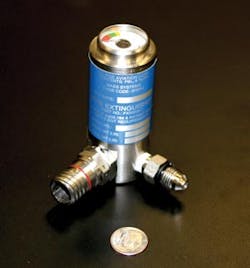Last year Eclipse Aviation announced that it will use a new fire extinguishing agent called PhostrEx in the Eclipse 500. This new fire suppression system has received approval from the Environmental Protection Agency (EPA) and has passed all FAA certification fire testing. We will take a look at the PhostrEx fire suppression system and discuss how it will affect the aviation industry.
Halon Nomenclature
Halon is a term used to describe halogenated hydrocarbons. These materials contain combinations of carbon (C), fluorine (F), chlorine (Cl), bromine (Br), and iodine (I). The halon suffix is based on the number of atoms of each element present in the compound. The numbered suffix for CaFbClcBrdIe would be Halon abcde. However, if there is a zero trailing an element it is dropped. Halon 1301 used in aviation applications is CF3Br.
Halon evolved as a replacement fire extinguishing agent for methyl bromide. Methyl bromide was an effective fire extinguishing agent, but it was toxic. The U.S. Army conducted research in the late 1940s to find a less toxic but still highly effective alternative to methyl bromide. Halons (and specifically Halons 1301 and 1211) were successful in a wide range of fire suppression applications, and became the fire suppressant of choice.
The Downside
In the 1970s, evidence began to emerge that certain man-made elements were having a detrimental effect on the environment, causing a thinning of the earth’s ozone layer. The environmental impact that Halons and other halocarbons led to the Montreal Protocol (The Montreal Protocol on Substances that Deplete the Ozone Layer) which was an international treaty to place limits on specific forms of pollution. The Montreal Protocol was signed in 1987 and called for a total ban on the production of many halogenated compounds (including Halons) in 1994. Subsequent amendments and implementation of the Montreal Protocol through the U.S. Clean Air Act have led to restrictions on the production and use of ozone-depleting compounds. The 1994 moratorium is in place, and the existing stockpiles of Halon are being conserved for critical uses including military and aviation applications.
Trying to Find a Replacement
Since the ban of Halon 1301, various government agencies including the Departments of Defense, Commerce, and Transportation have conducted research trying to find alternative fire suppressants. These research studies have identified alternatives that ended up being heavier, more costly, more toxic, or in other ways less suitable than Halons. Up until last year, Halon 1301 was the only fire suppression agent that was certified for aircraft fire suppression. All certificated aircraft basically relied upon an exemption from the Clean Air Act and the Montreal Protocol so that it could have a Halon 1301 fire suppression system in their engine compartments to be certified by the FAA. The military also continues to use Halon 1301 for suppression of engine and auxiliary power units, cargo bays, and cabin fires as well as for fuel tank explosion suppression.
Eclipse Aviation Looks for an Alternative Eclipse Aviation began investigating a replacement to Halon 1301 a few years ago as it was proceeding with development of the Eclipse 500. When looking for an alternative, the company asked two basic questions. First, are reactive agents more suitable as agents to suppress fires? And second, could they exploit flow patterns in a fire to use fire extinguishing agents more efficiently, rather than flooding the fire zone with extinguishing materials?
The reason that Halon 1301 is so effective in fire suppression is its chemistry. The primary difference between Halon 14 (CF4) and Halon 1301 (CF3Br) is the presence of a bromine atom in Halon 1301. In a hot fire, the Halon 1301 molecule decomposes and releases the bromine atom in the combustion zone. Bromine catalyzes a recombination of reactive chemical species in the flame shutting off the heat release and extinguishing the fire. But the bromine that makes Halon 1301 so effective also makes it harmful to the ozone layer. Bromine in the stratosphere plays a similar catalytic action, converting ozone to molecular oxygen.
Although Halon 1301 releases bromine into the flame, it does so reluctantly. The bond between carbon and bromine in Halon 1301 is quite strong, and the rate of bromine release is quite slow at typical flame temperatures. It was realized that if a chemical compound could be developed that could release bromine more easily than Halon 1301, it might be more effective in suppressing a fire. This quicker release is possible using a broad class of materials with weakly bound or labile bromine.
PhostrEx Agent
A freelance scientist approached Eclipse Aviation around three years ago with a patented material he thought might be of interest to them. Eclipse engineers saw value in his discovery and quickly set up a project to certify the suppressant on the Eclipse 500. The result of that project is PhostrEx — a labile bromine compound chemically referred to as phosphorous tribromide (PBr3). PhostrEx is 87 percent bromine by weight and reacts rapidly with moisture in the air to produce simple, water-soluble acids HBr and H3PO3. This reaction occurs rapidly (0.087 seconds at 50 percent relative humidity). As a result of this quick reaction, the agent cannot be transported to the stratosphere and therefore has no ozone depletion potential. Its byproducts are rapidly deposited by rainfall to the ground and neutralized to simple salts. In a fire, PhostrEx decomposes about one thousand times more rapidly than Halon 1301. It is a very efficient fire suppressant.
Weight Reduction
One of the advantages of PhostrEx agent is the weight savings. It is much more potent than Halon — two teaspoons of PhostrEx agent are equivalent to 2 ½ cups of Halon. In the Eclipse, the total weight of the PhostrEx fuel suppression system is about 90 percent less than a traditional Halon system would have been.
Maintenance Issues
The PhostrEx fire suppression system is less complex than a Halon system, and is designed to be maintenance free for 10 years. After 10 years, a mechanic simply removes and replaces the hermetically sealed canister. This eliminates typical hydrostatic and visual five-year inspections typically associated with Halon systems.
Health Risks
Eclipse wanted to ensure there would not be any significant health risks with exposure to PhostrEx agent. Since PhostrEx is a reactive agent, it was important to understand any potential toxicity issues. The cartridge is hermetically sealed and is not serviceable. So maintenance personnel don’t handle the chemical itself. Even in the case of accidental discharge of the cartridge, localized concentrations of water-soluble acids are produced that are easily and safely cleaned with water.
Corrosion Concerns
Eclipse performed extensive studies on the compatibility of PhostrEx agent to the various materials used in the engine and nacelle area. In addition to the certification tests that were performed, Eclipse is performing compatibility testing on all materials within the engine area including stainless steels, aluminums, wiring harness materials, nacelle composite materials, and the like. All testing so far shows that PhostrEx has no adverse interactions with these materials.
Looking Ahead
Eclipse is looking ahead to additional installations of the PhostrEx fire suppression system. With all of the environmental issues of Halon, and with a viable alternative now available, there will likely be increased pressure by the EPA for conversion to PhostrEx fire suppression systems. So even if you never work on an Eclipse 500, chances are you will still stumble across a PhostrEx fire suppression system in the future. It’s an emerging technology we will keep an eye on.





